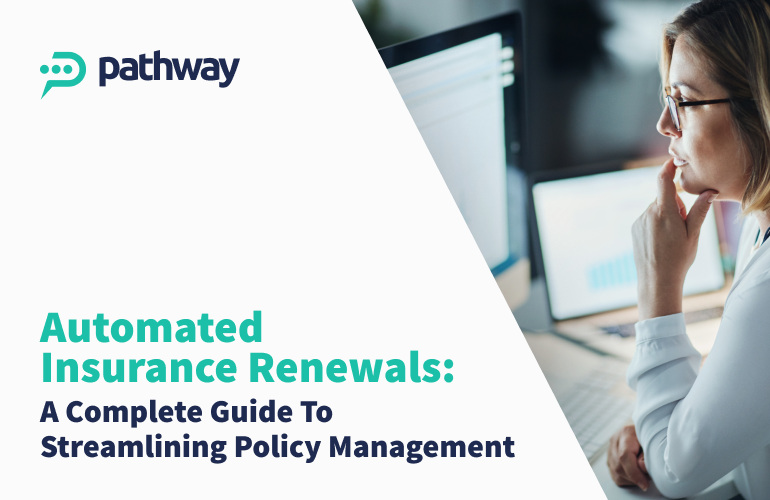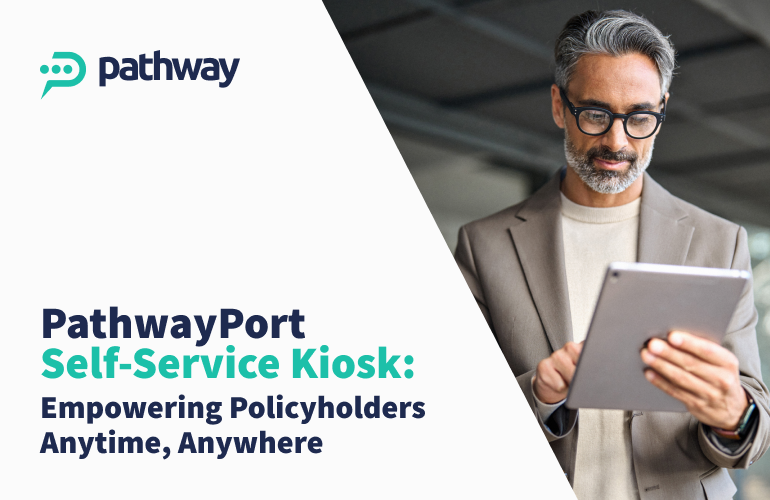
Automated insurance renewals are transforming the way policies are managed, making the insurance process faster, more accurate, and more convenient for both insurers and policyholders. By replacing manual tasks with smart, technology-driven workflows, renewals are now simpler, more efficient, and far less prone to errors — helping insurance brokerages and agencies deliver better service while keeping customers continuously protected.
Leading solutions like the PathwayPort self-service kiosk take this convenience even further, giving policyholders the ability to renew policies, make payments, and update information anytime — all without waiting for office hours or agent callbacks. This combination of automation and self-service is redefining the insurance experience for both customers and providers.
This comprehensive guide will walk you through what automated insurance renewals are, why they are important, the key benefits for both insurers and policyholders, and the main challenges to consider before implementation.
How Brokers and Agents Can Automate the Insurance Renewal Process
One of the most impactful areas where automation is driving change is in the insurance renewal process. Traditionally, renewals have been time-consuming and tedious, requiring:
- Collecting client information
- Preparing renewal quotes
- Generating policy documents
- Sending renewal notices
- Tracking follow-ups
- Processing payments
- Updating client records
With automated insurance renewals, many of these steps can be completed faster, with greater accuracy and less human intervention. Here’s how automation can simplify each stage:
1. Collecting Client Information
Automation allows insurers to gather updated client information electronically, eliminating manual data entry and improving accuracy.
2. Preparing Renewal Quotes & Policy Documents
Systems can automatically generate quotes based on existing policy data and underwriting rules, then create consistent, error-free policy documents instantly.
3. Sending Renewal Notices
Automated reminders can be sent via email, text, or app notifications well before a policy’s expiration date — often starting 60 days in advance — to give policyholders ample time to act.
4. Following Up on Renewals
Automation can track each policy’s renewal status and trigger tailored follow-up messages depending on the customer’s actions (or inactions).
5. Processing Payments
Automated billing enables policyholders to make secure, recurring payments without manual intervention, reducing late payments and improving cash flow for insurers.
6. Updating Client Records
Once a renewal is complete, automation updates all relevant policy, payment, and contact details in real time, ensuring accurate, up-to-date records.
By digitizing these key steps, insurers not only speed up the process but also enhance the customer experience — creating a smoother path from renewal reminders to confirmed policy extensions.
What Are Automated Insurance Renewals?
Automated insurance renewals use software-driven workflows to handle the process of extending existing insurance coverage once a policy term expires. Traditionally, renewals involved:
- Sending paper notices by mail
- Calling customers to confirm details
- Manually entering data into systems
- Processing payments through multiple steps
With automation, most of these tasks are handled digitally and seamlessly, resulting in faster turnaround times, fewer human errors, and a better customer experience.
How Automated Insurance Renewals Work
A typical automated renewal workflow may include:
- Automated Renewal Reminders – Personalized notifications sent well before the expiration date.
- Data Collection & Verification – Secure online forms for updating details.
- Quote Generation & Document Creation – Automatic production of compliant quotes and documents.
- Payment Processing – Fast, secure online payments with instant confirmation.
- Automatic Record Updating – Real-time updates to policyholder data.
Why Automated Insurance Renewals Are Important for Insurance Brokers
Insurance coverage is not something policyholders can afford to forget about. A single missed renewal can lead to gaps in coverage, financial risk, and customer dissatisfaction. Automated insurance renewals help:
- Maintain continuous protection for customers
- Reduce administrative pressure on insurers
- Improve operational efficiency across the business
- Provide a smoother, more predictable experience for all parties involved
In a competitive industry where customer loyalty is hard-won, a streamlined renewal process can be a major differentiator.
Benefits of Automated Insurance Renewals
For Policyholders
- Convenience – No more tracking renewal dates or mailing payments.
- Reduced Risk of Lapses – Automated reminders and payment processing keep policies active.
- Faster Processing – Renewals can be completed in minutes instead of days.
- Personalized Experience – Communication and offers can be tailored to the customer’s needs.
For Insurers
- Increased Efficiency – Fewer manual processes free up staff for higher-value work.
- Reduced Errors – Automation minimizes mistakes in data entry and documentation.
- Improved Customer Retention – A smooth process encourages policyholders to stay.
- Cost Savings – Lower administrative costs mean higher profitability.
- Better Data Quality – Centralized, accurate records support business insights and compliance.
Challenges of Automated Insurance Renewals
While automation offers significant advantages, it’s not without challenges:
- Over-Reliance on Technology – Some renewals require human interaction, especially in complex cases.
- System Downtime or Failures – Technical issues can disrupt renewals and damage trust.
- Cybersecurity Risks – Automation requires strong data protection to prevent breaches.
- Integration Complexity – Connecting automation tools with existing systems can be difficult.
- Employee Resistance – Without proper training, staff may resist adopting new processes.
Best Practices for Implementing Automated Insurance Renewals
If you’re considering automation, follow these tips for success:
- Start with a Pilot Program — Test automation with a small group of policies before scaling.
- Maintain a Human Touch — Offer human support for customers who prefer speaking with a representative.
- Focus on Security — Invest in strong encryption and compliance measures to protect data.
- Train Employees Thoroughly — Ensure staff understand and embrace the new system.
- Integrate with Existing Tools — Choose automation platforms that work seamlessly with your CRM and payment systems.
PathwayPort Self-Service Kiosk: Empowering Policyholders Anytime, Anywhere
In today’s on-demand world, customers expect convenience, speed, and control — and the PathwayPort self-service kiosk delivers exactly that. Available 24/7, this powerful tool gives policyholders instant access to their insurance accounts from any location. Whether it’s renewing policies, making secure payments, updating contact details, or downloading important documents, PathwayPort streamlines every step of the process.
By removing the need to wait for office hours or speak with an agent, it empowers customers to manage their coverage on their own terms. This high level of accessibility works hand-in-hand with automated insurance renewals, ensuring policyholders enjoy a seamless, efficient, and personalized experience that strengthens trust and loyalty over time. Learn more about how to increase customer satisfaction with a self-service kiosk.

The Future of Automated Insurance Renewals
As customer expectations shift toward digital-first experiences, automated insurance renewals will continue to evolve. Advances in AI and machine learning may allow insurers to predict customer needs, offer tailored policy updates, and even proactively adjust coverage based on life changes.
For insurers, adopting automation isn’t just about convenience — it’s about staying competitive, improving retention, and delivering exceptional service in a market where speed, accuracy, and personalization matter more than ever.
Frequently Asked Questions About Automated Insurance Renewals
1. What are automated insurance renewals?
Automated insurance renewals are technology-driven processes that handle policy extensions without manual paperwork or phone calls. They use reminders, online forms, automated payments, and digital record updates to streamline the process.
2. How do automated insurance renewals work?
They work by sending reminders to policyholders before a policy expires, collecting updated information digitally, generating renewal quotes, processing payments online, and automatically updating records — all with minimal human intervention.
3. Are automated insurance renewals secure?
Yes, when implemented with strong encryption, authentication, and compliance measures, automated renewals can be very secure. Insurers should follow data protection regulations and regularly audit their systems to ensure safety.
4. What are the benefits of automated insurance renewals for policyholders?
They offer convenience, reduce the risk of coverage lapses, speed up the process, and provide more personalized communication.
5. Can automation completely replace human involvement in renewals?
Not entirely. While automation can handle most routine renewals, complex cases or situations requiring personal attention still benefit from human oversight.
6. What happens if the automated renewal system fails?
If the system experiences downtime, insurers should have backup processes in place, such as manual outreach or alternative payment options, to prevent coverage gaps.






Leave a Comment